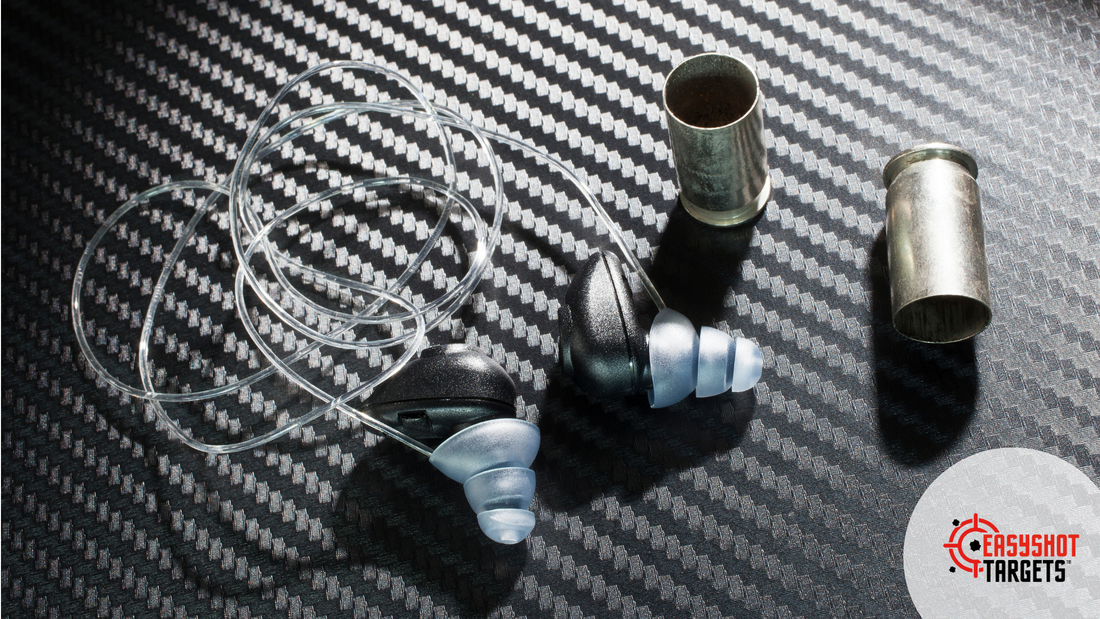Every now and then, you'll meet someone that claims that they don't "need" hearing protection when shooting a gun. They are simply incorrect, no matter what their excuse is. Hearing protection is essential in preventing hearing loss.
The decibel level of gunfire peaks between 140 and 170 dB. The ears are subjected to even more damage to the same noise at indoor ranges as it echoes off the walls, floor, and ceiling. Simply said, hearing protection is a must-have for range days.
We'll break down the different types of hearing protection in this article. You should have an idea of which hearing protection is best for you by the end.
Types of Hearing Protection
1) Earplugs
Earplugs come in a variety of shapes and multiple styles:
- Single-use
- Multiple-use
- Banded
- Molded
Single-Use Earplugs

Credit: Envato Elements/ Lightitup_now
The majority of these are made of soft extensible PU foam. The plug is compressed between the wearer's fingers before being inserted into the ear canal, where it expands to seal against the specific curves of the wearer's ear. These are low-cost, single-use items that come in both corded and uncorded versions.
Multiple-Use Earplugs

Credit: Envato Elements/ puibunny
These are frequently made with flexible ridges or flaps that circle the plug and let it seal comfortably against the ear canal. They are normally made of washable soft plastic or silicone rubber. The corded and uncorded alternatives come in a reusable plastic casing that can be resealed.
While they are more expensive than disposable foam earplugs, they can actually save you money over time. The dollar invested on a pair of multiple-use earplugs can go a lot further than the pennies spent on each pair of single-use earplugs if they are properly cared for and maintained.
Banded Earplugs

Credit: Envato Elements/ towfiqu98
Banded earplugs, which are a set of earplugs kept together by a plastic band, are another multi-purpose choice. They're a cross between an earmuff and an ear plug-in that combine the portability and convenience of earplugs with the simplicity of earmuffs.
The band's pressure makes it easy to put on, and users can simply put them on, stroll into a noisy place, and then take them off when they leave. The majority of them can be stowed in a pocket or worn around the neck.
Molded Earplugs

Credit: Envato Elements/ Daria_Nipot
Molded earplugs are likely the most effective option among earplugs. In the past, they had to be custom constructed by a company and you had to wait for them to be completed. That is still the case in many circumstances, and the best-molded earplugs can cost considerably more than $100.
They are usually equipped with removable filters and are extremely subtle and comfortable to use.
2) Earmuffs
Earmuffs are popular among those who spend time at a shooting range, where they are exposed to not just their own gunshot but also that of the other shooters. Earmuffs have a high noise absorption level, which is ideal for high-impact noises such as gunfire.
Earmuffs are divided into two categories: passive and electrical.
Passive Earmuffs

Credit: Envato Elements/ LightFieldStudios
For good reason, passive earmuffs are the most popular among recreational shooters. They offer great hearing protection at an extremely low cost.
Passive earmuffs can block out nearby sounds by forming an insulating sound barrier. The major disadvantage of passive ear protection is that it reduces all noise, even if it isn't particularly loud. As a result, having a discussion with a shooting friend without shouting back and forth can be tough.
Electronic Earmuffs

Credit: Envato Elements/ AlexVog
Electronic earmuffs are popular among shooters because they provide adequate noise reduction for most shootings while also allowing the wearer to hear conversations and other safe noises. Some systems even magnify very quiet noises, allowing for better situational awareness during hunting or training.
Electronic earmuffs work by transmitting all external sound to the ears via small, built-in microphones. When the sound processor in the muffs detects a dangerous sound (such as gunfire), it turns off the microphones before the sound reaches the wearer, thereby turning the muffs into passive earmuffs.

Noise Reduction Rating(NRR)
When looking for hearing protection, you'll want to know how well the device decreases your noise exposure and reduces the sound intensity to a safe level. The noise reduction rating (NRR) of hearing protectors specifies the amount of noise reduction they can provide. The NRR indicates the average sound level reduction produced by hearing protection. A higher NRR suggests that the system is more effective in reducing noise levels.
Any sort of hearing protection, regardless of NRR, requires a proper fit to function properly. Hearing protection must fit properly, especially for children and people who are new to shooting.
Earmuffs with a padded headband and adjustable earcups give a very comfortable fit for a wide range of shooters, including youngsters, ladies, and others with smaller heads.
Make sure that before placing earplugs deeply into the ears, they must be rolled and compressed between the fingers. They must be flush and fully inflated deep inside the ear canals to function effectively.
Summary
So, which is the best ear protection for you? This is ultimately determined by your requirements. Everyone's ear health threshold is different. If you wish to limit noise, you might want to consider using hearing protection earmuffs. If you go to the gun range or go hunting on a regular basis, you'll need custom earplugs.
Regardless of what you're shooting or how often you're firing, never shoot without wearing hearing protection. Investing a few minutes in finding the correct form of ear protection can go a long way toward preventing hearing damage and ensuring that you can keep shooting for a long time.

